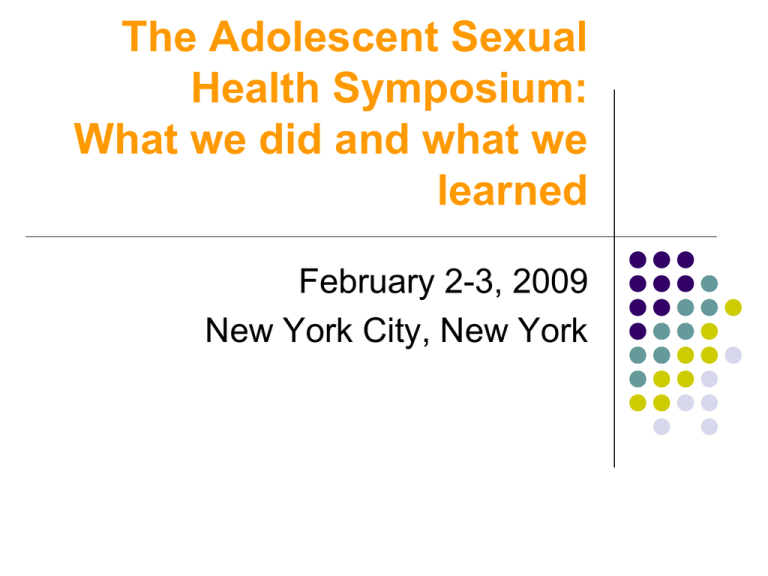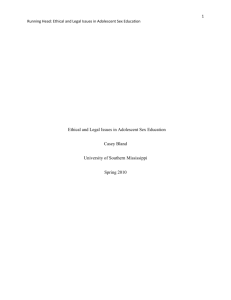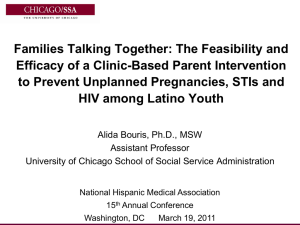The Adolescent Sexual Health Symposium
advertisement

The Adolescent Sexual Health Symposium: What we did and what we learned February 2-3, 2009 New York City, New York Purpose To learn about and explore the latest research and best practices regarding the promotion of the optimal sexual health of young people To bring together experts in the field with practitioners, policy makers, emerging leaders, health advocates, and youth to inform future DOH initiatives Symposium Themes Current trends in adolescent sexual behavior Disparities in access to adolescent sexual health services, information, and education Ecological influences: environments, relationships and adolescent sexual health New information and communication technologies Panel of Experts Claire Brindis, UCSF Sarah Brown, National Campaign to Prevent Teen and Unplanned Pregnancy Michael Carerra, Childrens Aid Society Alwyn Cohall, Harlem Health Promotion Center, Columbia University Angela Diaz, Mt. Sinai Adolescent Health Center Ralph DiClemente, Emory University Douglas Kirby, ETR Associates Jonathan Klein, UR-Division of Adolescent Medicine Deborah Levine, Internet Sexuality Information Services Guillermo Prado, University of Miami John Santelli, Columbia University Other Stakeholders State Agencies Advocacy Groups National Funders NYC agencies Providers Other Youth Technology “Technology is a gift to public health” - Sarah Brown Vital to youth Potential exploding Can help address racial/ethnic disparities Emerging, innovative strategies: NOT evidence-based ISIS-Inc: Deb Levine Internet Sexuality Information Services: www.isis-inc.org SexInfo InSPOT Harlem Health Promotion Center: Alwyn Cohall Use technology to: Make use of waiting time Improve assessment Educate patients Reach partners Clinical Services & Service Delivery Break down silos Holistic and youth-friendly Training Funding SILOS: Ralph DiClemente The time for incremental changes has passed. A bold and innovative initiative is needed. Ultimately, political and public health resolve and leadership to is needed to create an integrated continuum of sexual health services and effective delivery systems to eliminate racial disparities. Holistic, Youth-Friendly Services Move beyond a problem focus; help young people build skills Tailor services to youth Understand the familial and cultural context Training “Young people see their worth in that worker’s eyes.” - Michael Carrera Funding We must always remember to address funding. “Keep talking about money.” - Sarah Brown Information, Education, & Curriculum-Based Programs Media / awareness campaigns School-based education Effective Programming Media / Awareness Campaigns Engage youth Go positive—and fun! Target messages Use technology, but be smart about it School-Based Education School-based health clinics Gay/Straight Alliances Service-Learning Comprehensive sexual health education Curriculum-Based Programming 17 Characteristics of Effective Programs http://www.thenationalcampaign.org/ea2007/ characteristics.pdf One size will not fit all Implement with fidelity Positive content; broad perspective Positive Youth Development Programs can’t do it all. Engage youth Engage families Engage communities Youth Involve young people in decisionmaking roles at every level Design Implementation Evaluation Families Connectedness is protective Broad definition of “family” Some parents can become sexperts! High aspirations Latino and African American family strength Communities Alignment Opportunities for contribution Supportive relationships with adults Advocacy Adolescent sexual health poster designed by Kristy C. Jerkins and Kruti Sheth, based on NYS DOH Adolescent Sexual Health Working Groups definition of sexual health Additional Resources Using Media and Technology to Improve Sexual Health Outcomes for Youth (2010) - Alwyn Cohall, MD, demonstrates that in clinical practice, using youth-friendly technology can lead to far better outcomes for adolescent sexual health. Using New Media to Promote Adolescent Sexual Health (2009) Deb Levine describes some of the new media and communications technologies that have become popular in recent years, together with case examples demonstrating how these technologies are being used for sexual and reproductive health. Adolescent STI/HIV Prevention Programs: What Works for Teens? (2010) Jessica M. Sales and Ralph J. DiClemente examine why STI rates are so high among adolescents and explore strategies that program providers can use to help adolescents effectively reduce their risk. A New Vision for Adolescent Sexual and Reproductive Health (2009) John S. Santelli and Amy T. Schalet review historical and cultural contexts—particularly adult attitudes toward adolescent sexuality—to point us toward healthier outcomes in the United States.











